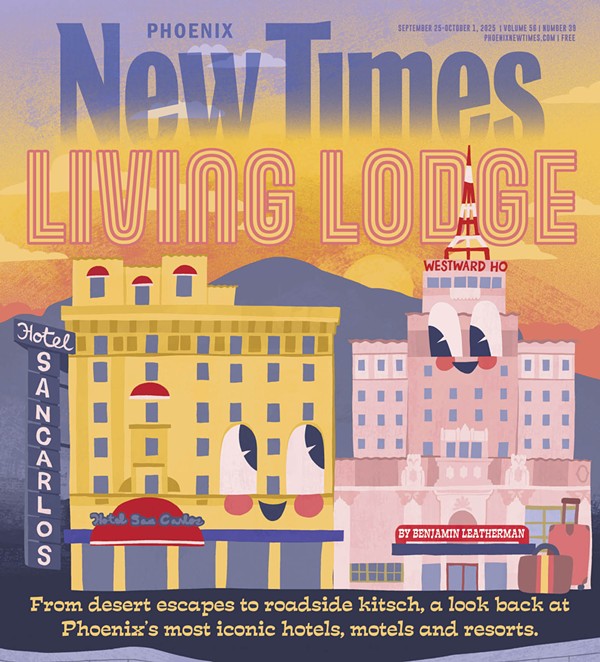After all, the 24-year-old artist harbors an obvious obsession with mortality. Her artwork is more still-dead than still-life, often incorporating fragments of animal skeletons or human skulls, and the bleak landscapes she paints, with titles like The Nightmare, have earned the moniker of macabre more than once.
And then there are her own nightmares, which haunt her constantly, her jet-black hair -- a must for any self-proclaimed goth kid -- and her extensive collection of jarred animal carcasses, displayed casually in a back room of her central Phoenix home.
Indeed, it's all too easy to assume that Bess endured a childhood riddled with pain, or a traumatizing teen life, but Bess is determined to make our conclusions about her -- and her artwork -- harder to reach.
On the exterior, there's nothing about Bess' two-bedroom home that screams "house of the dead." Desert life flourishes in front, grapevines cling to the side of the house, and petite cantaloupes sprout in oversize flowerpots in back. Bess' Phoenix neighborhood, filled with older homes, is a quiet stop between the gritty section of Indian School Road, near the VA Hospital, and Camelback Road, five minutes from the glitzy Biltmore shopping center.
Bess greets visitors with a bashful hello and a slight smile, only to be upstaged by an attention-hungry Bengal cat named Lasa [sic] Velocity (after the Tibetan city Lhasa and the cat's breakneck pace). The brawny feline writhes around on an antique chair in the front room, one of only a few pieces of furniture in the house.
Bess, who teaches drawing at the New School for the Arts in Tempe, is truly a minimalist -- her unadorned walls and natural complexion say so. But the clutter of cleaning supplies, painting materials and random junk on the floor indicate her recent move from the Citywide Studios complex on 15th Avenue, an artsy alcove of downtown Phoenix.
Now, she has her own studio in her own backyard -- a garage turned painter's digs. Just like the rest of her house, the studio is still in the works, so there's little to gawk at. A stack of ornate, antique frames, which Bess uses for her smaller pieces, sits in the corner of the stuffy studio, and only one large painting, the aforementioned The Nightmare, is propped against the wall.
Like many of her paintings, The Nightmare is surreal at its simplest. With murky jade waters as its backdrop, the painting depicts two masked women, one crouched feebly on the seabed, her arms clutching her naked body, the other more clownlike in appearance gazing down at her. Fish skeletons float aimlessly by the fray, completing a scene that's all too familiar to the nightmare-prone artist. Bess adds that she also suffers from night terrors, a phenomenon that violently wakes its victims from slumber.
The lone painting hanging in her bedroom, Fishing in Darkness, is similarly dismal. The piece, which covers an entire wall, shows a woman fishing with an antique egg beater (in darkness, of course), her head draped in a squid carcass, as if it were the fashion.
Bess will eventually whip up her baroque-like oil paintings in her studio, but it's inside the house where she milks her inspiration.
Stemming from a lifelong fascination with natural history and forensics, Bess fills an otherwise empty room with animal remains. Dozens of jars, once filled with sweet Smuckers jam or spicy Tostitos salsa, now line the walls, stuffed with fermented snakes, eels, turtles and mice. A few were her pets at one time, but most she inherited from willing pet store owners.
"I get irritated with people out here -- how when something dies they just throw it away," says Bess, brushing aside a black hair ribbon from her eyes. "I like to keep them around."
And she has since she was a child growing up in Tempe, hoarding dead birds or lizards in her closet. She offers no real impetus for the hobby -- only that it runs in the family. Unbeknownst to Bess until she started college, her microbiologist mother once kept her own closet-dwelling collection of dead reptiles and rodents.
She also admits that keeping her lifeless friends around doesn't hurt when it's time to paint what she calls her "narrative illustrations," holding steadfast to her motto, "In Science I Trust."
"All my paintings have some origin in science," says Bess, who often paints herself into her work as well. "I have the same emotions and passion for the sciences and the natural world as a lot of people have about religion and Jesus."
Bess' recent installation, which ran at the Herberger Gallery in Phoenix from April through June, reflected this religion. Pieces like Half-Reanimated Hummingbird, which borders a delicate Hummingbird skeleton in a garish golden frame, Medusa, Medusae and Venus Got Lost all include some element of the natural world, either living or dead.
Half-Reanimated Hummingbird was the only piece from the Herberger collection to sell (pieces ranged from $275 to $1,800), but while Bess is still a novice when it comes to making art for profit, her palette has remained full. Since graduating from ASU in 2001, Bess has shown her work at Modified, monOrchid and Studio LoDo, all in Phoenix, and ASU's Step Gallery. The Herberger pieces will relocate to the Dollhaus Art Gallery in Williamsburg, New York, this December, and she's planning a show for January at the Casa Grande Museum.
If painting is Bess' way of praying to her own god, the "jar room" alone could be her temple.
Framed butterflies, stuffed armadillos and mummified rabbits accompany the jars, and an unopened box in the middle of the room boldly states "Fragile: TEETH" -- as in human, canine or miscellaneous. Clearly her prized possession, Bess lights up at the mere thought of collecting molars from friends and strangers. Even her grandmother has donated to the pile.
Two bookcases guard different corners of the room, each indicative of her dueling personalities. One houses medical dictionaries, forensic files and surgery manuals. The other is a tribute to Andy Warhol and the Dutch still-life painters that she says inspire her work. Other than this literature, a lone easel with a drawing of a tattooed male model is the only other true indication that an artist -- not a scientist or psychopath -- inhabits the house.
In fact, if it weren't for her delicate stature and subtle demeanor, one would half expect someone with Bess' pastime to hide houseguests in a ditch and force them to apply rich layers of lotion, à la The Silence of the Lambs. But Bess, the pixie that she is, is more sweet than scary and far more frightened of death than enamored of it.
"I guess that's why I hold onto things for so long," she says. "I don't want to let them go. I don't like [death] at all."
Bess is fully aware of how this all looks. While she proudly shows off her great-great grandmother's china cabinet, now filled with skulls, dog bones and a human skeleton she bought on eBay, she hesitates to explain each item. And while she often uses images or actual parts of dead animals in her paintings, she sighs at the assumptions people draw.
"If your work has a lot of skulls and dead shit in it, then people tend to think that you're into Slayer or something," says Bess, whose homemade shirt appropriately reads "Fighting death through re-animation." "But I'm really not like that."
Bess has the proof to back up her claim that she's more sugar than cyanide. She sleeps with a quilt her grandmother made, for instance, which adds some country charm to the independent, only child. (So what if the patches Grams sewed together represent Bess' collection of animal-filled jars?)
She proudly displays family photos on the shelves, shyly admits her pink shoes come from Hot Topic and giggles at the makeshift yearbook her teenage students created for her.
And, oh yeah, she loves to bake. A crusty pan sits atop the oven, suggesting Bess baked a dozen muffins in her new house before unpacking a single box. Offer her your decayed wisdom teeth, and the giddy girl might present you with a peach pie, one of her specialties.
Bess' true self comes across more subtly in the murky images of her artwork. Both realistic and figurative, Bess' paintings suggest more of a tongue-in-cheek approach to death and the natural world than her critics would have you believe. In Conversation, for instance, Bess has painted herself speaking to Saint Catherine's mummified head.
"There's a lot more to it than that, but again, I don't want to tell people what they should be thinking about when they look at the work," Bess says. "If they come up with a completely different narrative about some sci-fi sex trade worker catering to the race of anato-robots, and that works for them, then great, I'm glad to be a part of it."
No doubt, there are some who'd like her to be the tortured artist who mutilated puppies as a child and now re-creates their remains on canvas. That, after all, is the easy conclusion to reach. But Bess seems to be more forgiving about the metaphors people read into her work than her personality.
"In the end," she says, "I just really want to have done some good paintings."










